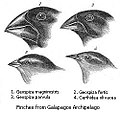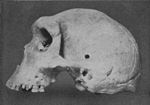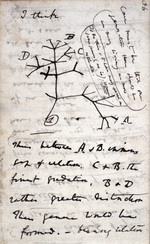 | Punctuated equilibrium (category Speciation) especially peripatric speciation as applied to the fossil record. Although the sudden appearance of species and its relationship to speciation was proposed and... 52 KB (5,614 words) - 12:36, 20 April 2024 |
Evolutionary Paleobiology: Essays in Honor of James W. Valentine in 1996, and New Approaches to Speciation in the Fossil Record in 1995. "Advisory board: Current... 2 KB (172 words) - 19:11, 16 February 2023 |
 | Megalodon (category Fossil taxa described in 1835) Archived from the original (PDF) on 19 October 2013. Benton, M. J.; Pearson, P. N. (2001). "Speciation in the fossil record". Trends in Ecology and Evolution... 137 KB (13,112 words) - 18:35, 21 March 2024 |
Speciation is the evolutionary process by which populations evolve to become distinct species. The biologist Orator F. Cook coined the term in 1906 for... 77 KB (8,138 words) - 01:34, 7 March 2024 |
geographic speciation, vicariant speciation, or its earlier name the dumbbell model: 86 – is a mode of speciation that occurs when biological populations... 94 KB (10,106 words) - 03:04, 30 March 2024 |
Glossary of genetics and evolutionary biology (redirect from Glossary of speciation) allo-parapatric speciation A mode of speciation where divergence occurs in allopatry and is completed upon secondary contact of the populations--effectively... 144 KB (15,393 words) - 06:54, 23 February 2024 |
In 1995, D. H. Erwin, et al. published a major work—New Approaches to Speciation in the Fossil Record—which compiled 58 studies of fossil speciation (between... 235 KB (27,140 words) - 13:22, 22 March 2024 |
Chimpanzee–human last common ancestor (category Events in biological evolution) due to its fossil incompleteness and the proximity to the human-chimpanzee split, the exact position of Ardipithecus in the fossil record is unclear.... 19 KB (2,294 words) - 11:15, 17 April 2024 |
 | Hominini (redirect from The human clade) Sahelanthropus and Orrorin existed during the estimated duration of the ancestral chimpanzee–human speciation events, within the range of eight to four million years... 23 KB (2,377 words) - 13:20, 5 April 2024 |
This list of fossil arthropods described in 2018 is a list of new taxa of trilobites, fossil insects, crustaceans, arachnids, and other fossil arthropods... 175 KB (9,235 words) - 08:52, 7 March 2024 |
 | Diadema (sea urchin) (section Fossil record) seagrass. The fossil record of Diadema is extremely poor, consisting only of spines that possibly belong to the genus, some of which go back to the Miocene... 4 KB (280 words) - 15:52, 14 October 2023 |
 | Marcellus Formation (category Oil-bearing shales in the United States) speciation in the fossil record. New York: Columbia University Press. ISBN 0-231-08248-7. Koutsoukos, Eduardo (2005). Applied Stratigraphy (Topics in... 102 KB (10,679 words) - 17:05, 31 March 2024 |
 | Divergent evolution (redirect from Divergent evolution in animals) divergent selection is the accumulation of differences between closely related populations within a species, sometimes leading to speciation. Divergent evolution... 15 KB (1,627 words) - 00:17, 24 April 2024 |
 | Stephen Jay Gould (category Fellows of the American Association for the Advancement of Science) the theory of punctuated equilibrium, which describes the rate of speciation in the fossil record as occurring relatively rapidly, which then alternates... 101 KB (10,566 words) - 12:47, 24 April 2024 |
 | Homo rhodesiensis (redirect from Bodo (fossil)) encephalization seen in fossils like the Bodo cranium is thought to have been a driving force in the speciation of anatomically modern humans. Both the Bodo cranium... 27 KB (3,024 words) - 21:48, 24 April 2024 |
 | The 21st century has seen a resurgence in the study of speciation, with new techniques such as molecular phylogenetics and systematics. Speciation has... 45 KB (5,398 words) - 05:18, 22 February 2024 |
 | Introduction to evolution (section Fossil record) speciation has been observed in present-day organisms, and past speciation events are recorded in fossils. Scientists have documented the formation of five new... 80 KB (9,137 words) - 00:59, 21 March 2024 |
 | Evolution (redirect from Origin of information in evolution) organisms undergoing speciation in novel habitats or small populations. As a result, the periods of stasis in the fossil record correspond to the parental population... 238 KB (24,700 words) - 04:40, 1 April 2024 |
 | Koinophilia (category Speciation) periods of time. Thus the fossil record suggests that evolution occurs in bursts, interspersed by long periods of evolutionary stagnation in so-called punctuated... 49 KB (4,983 words) - 21:05, 17 March 2024 |
 | Stratigraphy (redirect from Stratigraphical record) importance of fossil markers for correlating strata; he created the first geologic map of England. Other influential applications of stratigraphy in the early... 11 KB (1,215 words) - 15:11, 21 December 2023 |
Anagenesis (category Speciation) evolving species over time. The second process, speciation, is closely associated with cladogenesis. Speciation includes the actual separation of lineages... 15 KB (1,843 words) - 10:35, 19 April 2024 |
 | Adaptive radiation (category Speciation) trait values in their corresponding environments. Rapid speciation: presence of one or more bursts in the emergence of new species around the time that ecological... 38 KB (4,601 words) - 17:49, 16 March 2024 |
 | Lucy (Australopithecus) (redirect from Lucy (fossil)) the great apes. They also assumed the first traits to evolve after speciation related to intelligence: big brains, tool use, and complex language. In... 39 KB (4,468 words) - 18:16, 19 March 2024 |
Diversification rates (section Fossil time series) Diversification rates are the rates at which new species form (the Speciation rate, λ) and living species go extinct (the extinction rate, μ). Diversification... 4 KB (537 words) - 12:24, 8 September 2023 |
Quasillites (category Fossils of the United States) Indiana. J. J. Sepkoski Jr. 1998. Rates of speciation in the fossil record. Philosophical Transactions of the Royal Society Biological Sciences 353(1366):315-326... 3 KB (307 words) - 19:40, 26 August 2022 |
 | Onondaga Limestone (category Limestone formations of the United States) Formation". The Paleobiology Database. Retrieved 26 May 2008. Anstey, Robert L.; Erwin, Douglas H. (1995). New approaches to speciation in the fossil record. New... 13 KB (1,332 words) - 17:20, 8 December 2023 |
 | Genevievella (category Fossils of the United States) Sepkoski Jr., J.J. (1998). "Rates of speciation in the fossil record". Philosophical Transactions of the Royal Society of London B: Biological Sciences.... 6 KB (483 words) - 21:51, 17 December 2021 |



